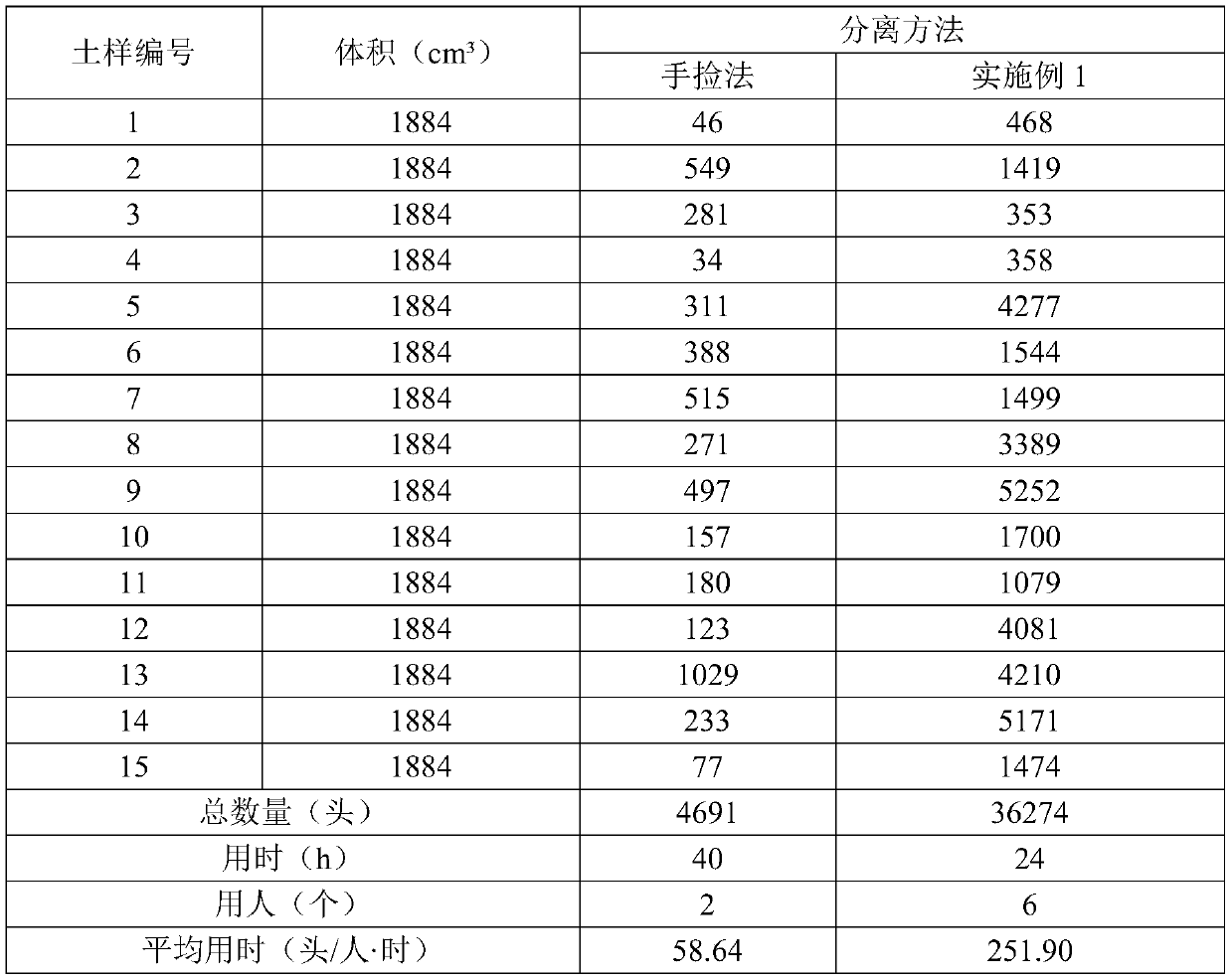Thecodiplosis japonensis larva separating method and application thereof
A separation method, the technology of sheath galls, which is applied in the field of separation of overwintering larvae of pine needle sheath gall mosquitoes, can solve the problems of high missed detection rate, labor-intensive, time-consuming, and low efficiency, so as to reduce the missed detection rate, fast and efficient separation, and save manpower and material costs Effect
- Summary
- Abstract
- Description
- Claims
- Application Information
AI Technical Summary
Problems solved by technology
Method used
Image
Examples
Embodiment 1
[0046] 1. Take a soil sample of 1000g, first use a 1# sampling sieve (diameter 20cm, height 6cm, aperture 4mm, 304 stainless steel material) to sieve out the litter, fallen leaves and large gravel in the soil sample, and lay a black polymer under the sampling sieve. Ethylene plastic film (0.5m x 0.5m, thickness 0.05-0.12mm, preferably 0.1mm) is used to receive the worm-infested soil samples sieved for future use.
[0047]2. Transfer the worm soil sample screened out by the 1# sampling sieve to the 2# sampling sieve (diameter 30cm, height 6cm, aperture 1.6mm, 304 stainless steel material) to sieve out the medium-sized gravel in the soil sample, and use the sampling sieve Lay a black polyethylene plastic film (0.5m * 0.5m, thickness 0.05-0.12mm, preferably 0.1mm) to receive the wormy soil samples that are sieved down for subsequent use.
[0048] 3. Transfer the worm soil sample screened out by 2# sampling sieve to 3# sampling sieve (diameter 30cm, height 6cm, aperture 0.45mm, pr...
Embodiment 2
[0052] 1. Take a soil sample of 1500g, first use a 1# sampling sieve (diameter 20cm, height 6cm, aperture 5mm, 304 stainless steel material) to sieve out the litter, fallen leaves and large gravel in the soil sample, and lay a black polymer under the sampling sieve. Ethylene plastic film (0.5m×0.5m, thickness 0.05-0.12mm, preferably 0.1mm) is used to receive the worm-infected soil samples sieved for future use.
[0053] 2. Transfer the worm-infected soil sample screened out by the 1# sampling sieve to the 2# sampling sieve (diameter 30cm, height 6cm, aperture 2mm, 304 stainless steel material) to sieve out the medium-sized gravel in the soil sample, and put it under the sampling sieve. Spread a black polyethylene plastic film (0.5m * 0.5m, thickness 0.05-0.12mm, preferably 0.1mm) to receive the wormy soil samples that are sieved down for subsequent use.
[0054] 3. Transfer the worm soil sample screened out by 2# sampling sieve to 3# sampling sieve (diameter 30cm, height 6cm, ...
Embodiment 3
[0058] 1. Take a soil sample of 1200g, first use a 1# sampling sieve (diameter 20cm, height 6cm, aperture 5mm, 304 stainless steel material) to sieve out the litter, fallen leaves and large gravel in the soil sample, and lay a black polymer under the sampling sieve. Ethylene plastic film (0.5m×0.5m, thickness 0.05-0.12mm, preferably 0.1mm) is used to receive the worm-infected soil samples sieved for future use.
[0059] 2. Transfer the worm soil sample screened out by the 1# sampling sieve to the 2# sampling sieve (diameter 30cm, height 6cm, aperture 1.6mm, 304 stainless steel material) to sieve out the medium-sized gravel in the soil sample, and use the sampling sieve Lay a black polyethylene plastic film (0.5m * 0.5m, thickness 0.05-0.12mm, preferably 0.1mm) to receive the wormy soil samples that are sieved down for subsequent use.
[0060] 3. Transfer the worm soil sample screened out by 2# sampling sieve to 3# sampling sieve (diameter 30cm, height 6cm, aperture 0.45mm, pre...
PUM
 Login to View More
Login to View More Abstract
Description
Claims
Application Information
 Login to View More
Login to View More - R&D
- Intellectual Property
- Life Sciences
- Materials
- Tech Scout
- Unparalleled Data Quality
- Higher Quality Content
- 60% Fewer Hallucinations
Browse by: Latest US Patents, China's latest patents, Technical Efficacy Thesaurus, Application Domain, Technology Topic, Popular Technical Reports.
© 2025 PatSnap. All rights reserved.Legal|Privacy policy|Modern Slavery Act Transparency Statement|Sitemap|About US| Contact US: help@patsnap.com

